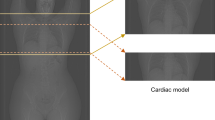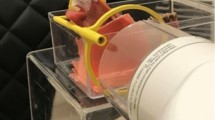Abstract
By acquiring the CT (Computed Tomography) simulation projection images of artistic relics, the visual expression ability of artistic relics is improved, and a method of acquiring CT simulation projection of artistic relics based on voxel model is proposed. The geometric primitive is established by using the geometric information of artistic objects, and the three-dimensional surface of the objects is reconstructed by the voxel model reconstruction method with intersecting surfaces. The surface rendering of artistic relics is divided into voxel level and slice level. The surface of the object composed of small patches is redrawn by using graphics. The slice level reconstruction method is used to reduce redundant patches in the CT simulation projection process of artistic relics, and the number of points and patches is reduced. By adjusting the transparency of the object, the result can not only show the outer surface of the object, but also the contour edge correspondence and contour stitching algorithm are used to improve the reconstruction accuracy and speed. According to the three-dimensional feature expression of voxel model, the fusion and reorganization of intermediate geometric primitives are realized. The simulation results show that the effect of CT simulation projection reconstruction and three-dimensional visual expression of artistic relics using this method is good, and the accuracy and speed of CT reconstruction of artistic relics are high.







Similar content being viewed by others
Data availability
The data used to support the findings of this study are available from the corresponding author upon request.
References
Zhang Hong, Wu Zhiwei, Wang Jicheng, Gao Peichao (2021) Unsupervised band selection for hyperspectral image classification using the Wasserstein metric-based configuration entropy[J]. Acta Geodaetica Cartogr Sin 50(3):405–415
Chaudhuri J, Boettcher K, Ehrhard P (2022) Optical investigations into wetted commercial coalescence filter using 3D micro-computer-tomography[J].Chem Eng Sci 248(7):11–23
Song Heqian, Zhang Lunyong, Cao Fuyang et al (2021) Three-dimensional reconstruction of bifilm defects[J]. Scr Mater 191(1):4–18
Casa R, Upreti D, Palombo A et al (2020) Evaluation and exploitation of retrieval algorithms for estimating biophysical crop variables using Sentinel-2, Venus, and PRISMA satellite data[J]. J Geodesy Geoinf Sci 3(4):79–88
Wei S, Huan Z, Quanyu W et al (2022) The application of X-ray micro CT imaging technology in the research of metal cultural relic production technology and evaluation of corrosion status [J]. Cult Relics Prot Archaeol Sci 34(6):51–59
Peichen Z (2022) Application of X-CT combined with AR technology in the restoration of unearthed bronze cultural relics [J]. Cult Relics Prot Archaeol Sci 34(6):60–68
Hu P, Munteanu A (2021) Method for registration of 3D shapes without overlap for known 3D priors[J]. Electron Lett 57(9):1889–1893
Li F, Pan WZ, Xiang W et al (2022) Automatic segmentation of multitype retinal fluid from optical coherence tomography images using semisupervised deep learning network[J]. Br J Ophthalmol 57(5):2669–2688
Wei Lifei, Yu Ming, Zhong Yanfei et al (2020) Hyperspectral image classification method based on space-spectral fusion conditional random field[J]. Acta Geodaetica Cartogr Sin 49(3):343–354
Liang Yueji, Ren Chao, Huang Yibang, Pan Yalong, Zhang Zhigang (2020) Multi-star linear regression retrieval model for monitoring soil moisture using GPS-IR[J]. Acta Geodaetica Cartogr Sin 49(7):833–842
Hou H, Jin Q, Zhang G et al (2022) CT image quality enhancement via a dual-channel neural network with jointing denoising and super-resolution[J]. Neurocomputing 492:343–352
Guo Aoqing, Hu Jun, Zheng Wanji, Gui Rong, Du Zhigui, Zhu Wu, He Lehe (2022) N-BEATS deep learning method for landslide deformation monitoring and prediction based on InSAR: a case study of Xinpu landslide[J]. Acta Geodaetica Cartogr Sin 51(10):2171–2182
Liu Guang, Zbigniew P, Stefano S et al (2021) Land surface displacement geohazards monitoring using multi-temporal InSAR techniques[J]. J Geodesy Geoinf Sci 4(1):77–87
Zhenhong LI, Chen YU, Ruya XIAO et al (2022) Entering a new era of InSAR: advanced techniques and emerging applications[J]. J Geodesy Geoinf Sci 5(1):1–4
Karamov R, Lomov SV, Sergeichev I et al. (2021) Inpainting micro-CT images of fibrous materials using deep learning[J].Comput Mater Sci 197(4):110551–110560
Acknowledgements
The study was supported by “Nantong Science and Technology Bureau 2022 Nantong Basic Science Research and Social Livelihood Science and Technology Plan Project (Grant No. JCZ2022045)”.
Author information
Authors and Affiliations
Corresponding author
Ethics declarations
Conflict of interest
The authors declare that they have no conflict of interest.
Additional information
Publisher's Note
Springer Nature remains neutral with regard to jurisdictional claims in published maps and institutional affiliations.
Rights and permissions
Springer Nature or its licensor (e.g. a society or other partner) holds exclusive rights to this article under a publishing agreement with the author(s) or other rightsholder(s); author self-archiving of the accepted manuscript version of this article is solely governed by the terms of such publishing agreement and applicable law.
About this article
Cite this article
Chen, X., Wang, L. & Ding, F. Computed tomography simulation projection acquisition method of artistic relics based on voxel model. Multimed Tools Appl 83, 32001–32017 (2024). https://doi.org/10.1007/s11042-023-16832-6
Received:
Revised:
Accepted:
Published:
Issue Date:
DOI: https://doi.org/10.1007/s11042-023-16832-6




